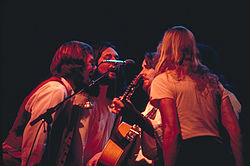Progressive rock
Progressive rock is a type of rock music with complicated musical technique and composition. This means that the tempo, time signature, and style can change many times in a single song.
| Progressive rock | |
|---|---|
| Other names |
|
| Stylistic origins | |
| Cultural origins | Mid- to late 1960s, United Kingdom and United States |
| Derivative forms | |
| Subgenres | |
| Fusion genres | |
| Avant-prog, progressive metal | |
| Other topics | |
Most normal rock songs follow a very simple pattern in the way they are arranged. This pattern is a verse followed by a chorus, then a different verse, and then the same chorus. Progressive rock is more complicated than this, and can require more skill to play.
Origins
Progressive rock was first made in the late 1960s, but became most popular in the 1970s. It continues to be popular today, too. Progressive rock began in England and spread throughout Europe. It remains most popular in Europe, but there are several notable American and Canadian progressive rock bands. This genre was influenced by classical music and jazz fusion. Over the years, different sub-genres of progressive rock have been created, such as symphonic rock, art rock, math rock, and progressive metal.
Progressive rock artists wished to create music that was not limited to the structures of common popular rock and pop music. They wanted to make rock music that "progressed" to the complexity of jazz and classical music by creating a more serious, complex and sophisticated type of rock music. Progressive rock bands may have influences from psychedelic rock, folk music, traditional music, world music, and jazz or jazz fusion. It is also referred to as "prog rock" as an abbreviation, or as "Hobbit rock" because of frequent medieval or fantasy themes in the lyrics.
Progressive rock bands write and play songs that have many changes during each song. Regular rock songs have verses and a chorus, but progressive songs can have many different sections. For example, instead of having verses and choruses, progressive rock songs may have many different musical themes, solos, and musical moods. A typical progressive song might have a form such as: Introduction-Verse-Chorus-instrumental section-New verse-New chorus-Instrumental section-Ending. Because of their depth and complexity, progressive rock songs are not played on pop music radio very often.
Bands
Some of the important progressive rock bands from the late 1960s and early 1970s include The Moody Blues, Jethro Tull, Yes, Genesis; Pink Floyd; Emerson, Lake & Palmer; Rush; Gentle Giant; Kansas: Happy The Man; Van der Graaf Generator, and King Crimson.

Characteristics of progressive rock
Progressive rock is difficult to define, because progressive rock bands often play different types of progressive rock music which sound different. There are some common elements that are in most progressive rock band music, such as long, complex songs, unusual time signatures, unusual instruments or ways of using them, and use of improvisation, which means making up or inventing music while playing on stage.
Albums by progressive rock groups are often concept albums. In a concept album, the songs have a common theme, are arranged in a certain order and often tell a story or represent a larger concept.
Progressive Rock Media
Pink Floyd performing The Dark Side of the Moon (1973), the best-selling album of the entire progressive rock period[8]
Emerson, Lake & Palmer were one of the most commercially successful progressive rock bands of the 1970s. They are seen here performing in 1992.
King Crimson's Robert Fripp believed that the prog movement had gone "tragically off course".[9]
Porcupine Tree performing in 2007
King Crimson performing at the Dour Festival, 2003
References
- ↑ Anon (n.d.). "Kraut Rock". AllMusic. Retrieved 25 January 2017.
- ↑ Macan 1997, pp. 22, 140.
- ↑ Lloyd-Davis, Isere (16 February 2017). "Paperlate: the modern witch goes prog". Prog. Retrieved 17 June 2018.
- ↑ "Post-Rock". AllMusic. Retrieved January 31, 2017.
- ↑ Macan 1997, p. 187.
- ↑ 6.0 6.1 "Pop/Rock " Art-Rock/Experimental " Avant-Prog". AllMusic.
- ↑ "Neo-Prog". AllMusic.
- ↑ Priore 2005, p. 79.
- ↑ Hegarty & Halliwell 2011, p. 177.
- Macan, Edward (1997), Rocking the Classics: English Progressive Rock and the Counterculture, Oxford: Oxford University Press, ISBN 0-19-509887-0





